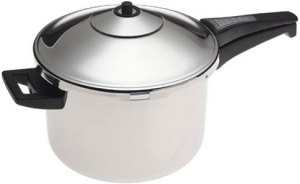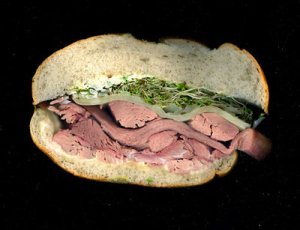 Here’s one simple tip so you never have to worry about HOW to cook what’s in your food preparedness.
Here’s one simple tip so you never have to worry about HOW to cook what’s in your food preparedness.
Many folks just plain don’t know how to cook with their food storage. When I hear this, I ask people why they’re storing foods that are unfamiliar to them or their family? Sure there are ideal lists which include long lasting grains and legumes, but if you’re not using such ingredients now to feed your family with, it’s not going to be helpful to them in an emergency. Think for just a moment what kind of chaos a financial collapse, an earthquake, an act of war, or some other kind of disaster could bring into your life. Do you really want to complicate things by adding more stress into your life by consuming “foreign foods”? You and your family are going to crave as much “normalcy” as possible. Unless you’re already serving your family “Boston Baked Wheat” you don’t want to try it out on them while they are being quarantined for 90 days as the result of a flu pandemic. In fact, it is exactly these kinds of times that you will want to provide the most comforting favorites for your family. But…yes, there is a but…
Part of being prepared is being ready to live off of foods which are most nourishing and longer lasting than what your diet may currently consist of in your household. (To this end I implore parents of picky eaters—or spouses of such—to do all they can to get them to embrace more nourishing foods.) Peanut butter and jelly sandwiches are great now. But how will they be when you have to make the bread from scratch? Will your family even touch them? Don’t panic. Just start learning the lost art of bread making now. I can tell you from experience that it’s a heck of a lot more rewarding than besting someone at an online game of Scrabble.
Slowly introduce your family to new things. For example, my husband, who I could never get to eat a vegetable unless it’s on a slab of beef, finally agreed to try and start putting sprouts on his meat sandwiches. Why? Because I was trying to get him used to eating this easy and widely accessible source of nutrition so when we would be in the midst of an emergency, he could handle it—not only emotionally, but physically as well. Being ready to live off those foods doesn’t involve just having the appetite for them. We need to be prepared to use them and work with them as well.
If you’ve never tried sprouting, don’t think that the sprouter you’ve got in the basement is going to do much for you in a time of crisis. Using it under such circumstances will only cause you more stress due to its unfamiliarity and you’ll avoid it at all costs.
You also need to get your body accustomed to eating such foods. In fact, if most people attempted to go from their existing diet to one containing whole wheat at the majority of their meals, under extreme circumstances, they would actually DIE inside of 90 days due to the dehydration and diarrhea their body would experience in so drastic a dietary change. This is one reason why I counsel people to store what they eat—at least a 90 day supply—and then work on introducing other, more stable storage foods, into their diet along the way. Yes, it’s a lot less expensive to store a year’s supply of wheat, legumes, honey, and powdered milk as opposed to the ingredients for your favorite casseroles, Navajo Tacos, and brownie mixes. But I assure you that those items won’t get used for much of anything if you haven’t already familiarized your family with them prior to a disaster. So be sure to have at least 90 days of the familiar and then work on familiarizing your family with other foods that will have a great shelf-life in your home. Remember, stress alters the mind. It races the heart. It breaks down the immune system.
If you’re in a quarantine situation, (ha! And to think I wrote this 15 years ago!) for example, can you really afford to expose anyone in your family to any of these physical stresses simply because you weren’t prepared with a realistic menu for them? Perhaps now you may better understand why I go to great lengths to learn how to make bread, sprout, store M&Ms, make sour cream out of powdered milk, wax my own cheese, store eggs long-term, and create recipes out of what’s on my shelves, etc. I do it in anticipation of a situation in which food and nourishment will be a comfort to the mind and the spirit, not just sustain life. (And yes, there are indeed those times in which M&Ms sustain me.) Ha!
I’ve been asked how I remember where all of my food storage is since it’s scattered all around the house. I remember because I’m always in it—except when I’m on that blasted diet. I’m always using what I store. I’m rotating it. (In fact I have a Mason jar full—er, half full—of almond M&Ms next to me on my desk as I write this.) Other than the years supply of MREs we have stored in the back of the basement, there’s not a single nutritional item in my home that is “uncommon” to me. If you have anything that’s uncommon to you in your food storage, it’s nearly useless.
 Point being, no one should have trouble cooking with their food storage, because their food storage should contain what they are already consuming and thus what they are already familiar in preparing. Practice making your food in a Dutch Oven, or in a pressure cooker over a small butane stove, or in a solar oven. Go to classes to learn how to make the essentials. They are usually free. Go through cook books and experiment with “less than fresh” items as substitutes in recipes, such as canned chicken for frozen, canned green beans for fresh, etc. Find out from your family what their absolute favorite meals are and then find the most efficient way to stock the items for those meals. We’re not in the dark ages here, folks. Cooking with your food storage doesn’t have to involve an Indian dance and an archaic tool for grinding your flour. Even without the luxury of electricity, we still will have the benefit of the luxury of knowledge and technology galore.
Point being, no one should have trouble cooking with their food storage, because their food storage should contain what they are already consuming and thus what they are already familiar in preparing. Practice making your food in a Dutch Oven, or in a pressure cooker over a small butane stove, or in a solar oven. Go to classes to learn how to make the essentials. They are usually free. Go through cook books and experiment with “less than fresh” items as substitutes in recipes, such as canned chicken for frozen, canned green beans for fresh, etc. Find out from your family what their absolute favorite meals are and then find the most efficient way to stock the items for those meals. We’re not in the dark ages here, folks. Cooking with your food storage doesn’t have to involve an Indian dance and an archaic tool for grinding your flour. Even without the luxury of electricity, we still will have the benefit of the luxury of knowledge and technology galore.
Keep in mind that in a previous article I wrote, I recommended that folks start their food storage by storing their food in “meals” as opposed to “pounds of items.” In other words, if your family loves waffles, then be sure you have the makings for waffles. If you have such ingredients sufficient to make them 12 times, then you only have to come up with 29 other meals. (Or less, depending on how often you want to eat waffles. I recommend coming up with a great variety for your family though so that they don’t suffer from “appetite fatigue.”)
It all boils down to this: Store what you eat and eat what you store.
UNDERwhelmed in Food Storage Series
- UNDERwhelmed in Food Storage Part 1 of 8
- UNDERwhelmed in Food Storage Part 2 of 8
- UNDERwhelmed in Food Storage Part 3 of 8
- UNDERwhelmed in Food Storage Part 4 of 8
- UNDERwhelmed in Food Storage Part 5 of 8
- UNDERwhelmed in Food Storage Part 6 of 8
- UNDERwhelmed in Food Storage Part 7 of 8
- UNDERwhelmed in Food Storage Part 8 of 8
For any questions or comments on this article, please leave a comment on the blog site so that everyone can benefit!
Copyright Protected 2009, Preparedness Pro and Kellene. All Rights Reserved. No portion of any content on this site may be duplicated, transferred, copied, or published without written permission from the author. However, you are welcome to provide a link to the content on your site or in your written works.




6 Comments
kelsomom · July 13, 2009 at 4:40 pm
I am in the process of slowly modifying my cooking to reflect what I am storing. My family will eat what I make…until they realize it’s from storage 🙂 All of a sudden it tastes ‘different’. Go figure.
kelsomom · July 13, 2009 at 4:40 pm
I am in the process of slowly modifying my cooking to reflect what I am storing. My family will eat what I make…until they realize it’s from storage 🙂 All of a sudden it tastes ‘different’. Go figure.
Shannon · July 13, 2009 at 5:45 pm
Well put!
I always wonder about groups who put up nothing but wheat berries and powdered milk, when the average American is picky about what brand of ketchup or mayo they eat, lol!
Shannon · July 13, 2009 at 5:45 pm
Well put!
I always wonder about groups who put up nothing but wheat berries and powdered milk, when the average American is picky about what brand of ketchup or mayo they eat, lol!
Comments are closed.